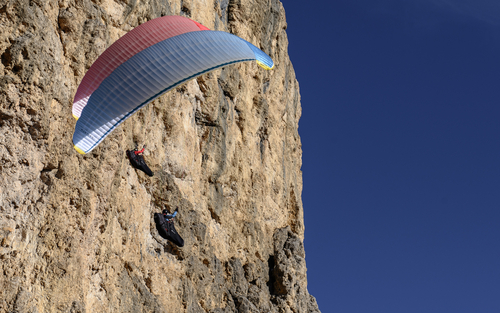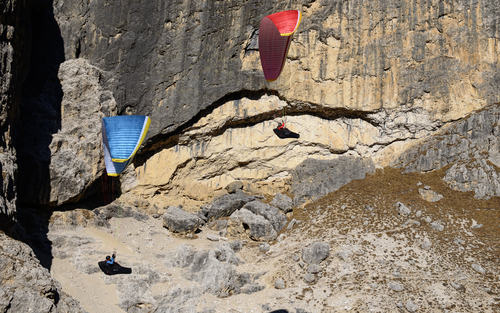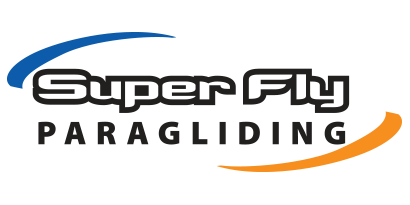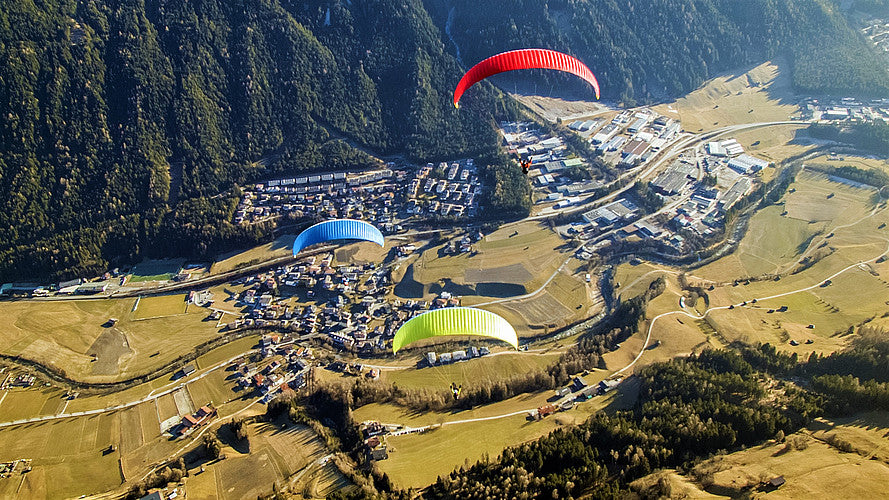Nova Mentor 5
$4,600.00
The benchmark of cross-country wings (EN/LTF B)
MENTOR 5 – Flying beyond boundaries
The Benchmark. For many years the MENTOR has been setting the standard for XC-intermediate wings. It combines impressive performance with a high degree of passive safety and it encourages you to exceed your boundaries. Using strength analysis optimization and flow simulation, we have succeeded in elevating the MENTOR 5 to a new performance level.

Relaxed Sportiness. The MENTOR 5 shows a marked performance increase on its predecessor. A slightly reduced trim speed leads to reduced sink and comfortable brake pressure, while the top speed remains consistently high. The handling distinguishes itself with its agility and precision. This permits the wing to simply centre in the thermal and take every climb.

Simply intuitive. Pilots should concentrate on what gives them pleasure: the flying. A clever mixture of materials has made the wing lighter, more manageable and more durable. At the most important points, the MENTOR 5 has been fitted with sheathed lines. As a consequence, the lines basically sort themselves. Launching is simple. And in flight, the MENTOR 5 helps you to find the right line.
Video
Requirements

The MENTOR 5 is a paraglider with impressive performance which has - in the hands of an experienced pilot - a very manageable handling and extreme flight behavior. Flying the MENTOR 5 does require a degree of skill. Although certified as EN B, the MENTOR 5 is not suitable for beginners and occasional pilots.
Impressions

"I flew a 240km flat triangle with an average speed of 30 km/h with the MENTOR 5. Unbelievable! This is the best MENTOR ever. I love this wing!"
Rinaldo Vuerich
NOVA team pilot after test flights in Kenya




Best Flights

Where the glider is flown in the weight-range is first and foremost a question of personal preference: anyone seeking a high degree of agility and dynamic flying should fly our wings at the higher end of the weight-range. Pilots who are happier with gentle flights with a high degree of damping will be happier in the middle of the weight-range. Of course, the flying conditions have a big influence - in turbulent, windy conditions greater wing loading will bring greater stability; whereas flying the glider at the lower end of the weight-range makes it unbeatable in weak thermals. Correct wing loading is mainly a question of personal preference and the conditions in which you mainly fly.
The brakes are components relevant to certification - modification can affect the flying characteristics and extreme flight behavior. Because of this, we strongly advise against any modification of the brake system. It is important that the brake has sufficient travel before it engages. This is also important so that the wing does not brake automatically when the speed bar is used. Furthermore a brake that engages too early affects performance and influences the recovery during incidents, for example during a collapse or when the canopy goes parachutal.
Performance data depends heavily on the drag created by the pilot and this is linked to their seating position and harness type. An aerodynamic harness or seating position can make the difference of one glide ratio point. We at NOVA never determine absolute performance data, instead we make comparisons with reference gliders. For this reason we do not publish performance data.
How a pilot holds the brakes is a matter of personal preference - but it does have a marked influence on the handling and flying characteristics of the wing. We recommend a half-wrap. You hold the brake handle in your palm and twist it half way around your hand so that the brake line lies between your thumb and forefinger. This shortens the brake travel by approximately 20 centimetres and this has a positive effect on feedback - firstly you directly feel the travel of the brake line and secondly, with the arms positioned higher, it is easier to feel the wing. Due to poor ergonomics, we recommend against not taking this wrap. The exception is of course when gliding or during other phases of the flight when steering with the brake is not necessary. Please note: when changing from not having a wrap to taking the wrap, the shortened brake travel must be taken into consideration.
Simplicity is our motto. Our wings can be packed using a concertina bag, but it is not essential. In principle, all our wings can just be stuffed in a packsack. When the wing is folded it is recommended not to bend the rods unnecessarily. This is particularly true if the wing is to be stored for longer periods. Furthermore, we recommend careful handling of your wing.
Sail cloth, lines and all other components are subjected to rigorous testing before they are used in serial production. We not only test the sail cloth for durability (high porosity or reduced tear resistance through UV damage or wear) but also for mechanical robustness, for example stretching. For quality control purposes we regularly take samples during serial production.
During the initial flights the lines are first subjected to load. This load induces a small degree of stretching and shrinking. These are not associated with the line manufacturers or the quality of workmanship - in the factory all NOVA paragliders are trimmed and pre-stretched to within a very low tolerance. To adjust this stretching or shrinking, we recommend that the wing is taken for NTT (Nova Trim Tuning) after ten to twenty flights - after one year at the very latest. Generally, the line lengths remain constant after the first ten to twenty hours. To use make full use of the NTT, Nova encourages all pilots to have their wing checked after ten to twenty flying hours.
Dry, not packed too tightly and if possible in a space without wide temperature variations - these are the conditions that make our paragliders feel well. You should never store a wing when it is moist. You should also avoid excessive heat, like you would have, for example, in the car. Never remove dirt using chemical detergents and/or brushes.
L
M
S
XS
XXS

![[Product_title] - Super Fly Paragliding](http://superflyinc.com/cdn/shop/products/csm_shot2_5064b5aa53_grande.jpg?v=1522418372)
![[Product_title] - Super Fly Paragliding](http://superflyinc.com/cdn/shop/products/csm_MENTOR5_Riser-4_1882c67781_grande.jpg?v=1522418372)
![[Product_title] - Super Fly Paragliding](http://superflyinc.com/cdn/shop/products/csm_shot1_8d46ad156c_grande.jpg?v=1522418372)
![[Product_title] - Super Fly Paragliding](http://superflyinc.com/cdn/shop/products/csm_Mentor5_NOVA-7241_57b9c356ed_grande.jpg?v=1522418372)
![[Product_title] - Super Fly Paragliding](http://superflyinc.com/cdn/shop/products/csm_shot3_c371ba3ef3_grande.jpg?v=1522418372)
![[Product_title] - Super Fly Paragliding](http://superflyinc.com/cdn/shop/products/csm_MENTOR5_slider_7fb2119140_grande.jpg?v=1522418372)
![[Product_title] - Super Fly Paragliding](http://superflyinc.com/cdn/shop/products/csm_Mentor5_NOVA-7547_589845956d_grande.jpg?v=1522418372)
![[Product_title] - Super Fly Paragliding](http://superflyinc.com/cdn/shop/products/csm_Mentor5_NOVA-7353_c0b49f9f0e_grande.jpg?v=1522418372)
![[Product_title] - Super Fly Paragliding](http://superflyinc.com/cdn/shop/products/csm_MENTOR5_intro6_d4f69309c8_grande.jpg?v=1522418372)
![[Product_title] - Super Fly Paragliding](http://superflyinc.com/cdn/shop/products/csm_MENTOR5_intro3_96e334dba3_grande.jpg?v=1522418372)
![[Product_title] - Super Fly Paragliding](http://superflyinc.com/cdn/shop/products/csm_MENTOR5_intro2_368953509c_grande.jpg?v=1522418372)
![[Product_title] - Super Fly Paragliding](http://superflyinc.com/cdn/shop/products/csm_Mentor5_NOVA-7272_91d9f270b9_grande.jpg?v=1522418372)
![[Product_title] - Super Fly Paragliding](http://superflyinc.com/cdn/shop/products/csm_Mentor5_target_7f0eb94457_grande.jpg?v=1522418372)
![[Product_title] - Super Fly Paragliding](http://superflyinc.com/cdn/shop/products/csm_MENTOR5_Riser_c42886d4d8_grande.jpg?v=1522418372)
![[Product_title] - Super Fly Paragliding](http://superflyinc.com/cdn/shop/products/csm_MENTOR5_Riser-7_ce4a1ec468_grande.jpg?v=1522418372)
![[Product_title] - Super Fly Paragliding](http://superflyinc.com/cdn/shop/products/csm_MENTOR5_Riser-6_946a52f9ce_grande.jpg?v=1522418372)
![[Product_title] - Super Fly Paragliding](http://superflyinc.com/cdn/shop/products/csm_MENTOR5_Riser-5_b1731d1467_grande.jpg?v=1522418372)
![[Product_title] - Super Fly Paragliding](http://superflyinc.com/cdn/shop/products/csm_MENTOR5_Riser-4_ff8d8f65e6_1_grande.jpg?v=1522418372)
![[Product_title] - Super Fly Paragliding](http://superflyinc.com/cdn/shop/products/csm_MENTOR5_Riser-3_7bdd1c3f85_1_grande.jpg?v=1522418372)
![[Product_title] - Super Fly Paragliding](http://superflyinc.com/cdn/shop/products/csm_MENTOR5_Riser-2_c247043def_1_grande.jpg?v=1522418372)

![[Product_title] - Super Fly Paragliding](http://superflyinc.com/cdn/shop/products/csm_shot2_5064b5aa53_compact.jpg?v=1522418372)
![[Product_title] - Super Fly Paragliding](http://superflyinc.com/cdn/shop/products/csm_MENTOR5_Riser-4_1882c67781_compact.jpg?v=1522418372)
![[Product_title] - Super Fly Paragliding](http://superflyinc.com/cdn/shop/products/csm_shot1_8d46ad156c_compact.jpg?v=1522418372)
![[Product_title] - Super Fly Paragliding](http://superflyinc.com/cdn/shop/products/csm_Mentor5_NOVA-7241_57b9c356ed_compact.jpg?v=1522418372)
![[Product_title] - Super Fly Paragliding](http://superflyinc.com/cdn/shop/products/csm_shot3_c371ba3ef3_compact.jpg?v=1522418372)
![[Product_title] - Super Fly Paragliding](http://superflyinc.com/cdn/shop/products/csm_MENTOR5_slider_7fb2119140_compact.jpg?v=1522418372)
![[Product_title] - Super Fly Paragliding](http://superflyinc.com/cdn/shop/products/csm_Mentor5_NOVA-7547_589845956d_compact.jpg?v=1522418372)
![[Product_title] - Super Fly Paragliding](http://superflyinc.com/cdn/shop/products/csm_Mentor5_NOVA-7353_c0b49f9f0e_compact.jpg?v=1522418372)
![[Product_title] - Super Fly Paragliding](http://superflyinc.com/cdn/shop/products/csm_MENTOR5_intro6_d4f69309c8_compact.jpg?v=1522418372)
![[Product_title] - Super Fly Paragliding](http://superflyinc.com/cdn/shop/products/csm_MENTOR5_intro3_96e334dba3_compact.jpg?v=1522418372)
![[Product_title] - Super Fly Paragliding](http://superflyinc.com/cdn/shop/products/csm_MENTOR5_intro2_368953509c_compact.jpg?v=1522418372)
![[Product_title] - Super Fly Paragliding](http://superflyinc.com/cdn/shop/products/csm_Mentor5_NOVA-7272_91d9f270b9_compact.jpg?v=1522418372)
![[Product_title] - Super Fly Paragliding](http://superflyinc.com/cdn/shop/products/csm_Mentor5_target_7f0eb94457_compact.jpg?v=1522418372)
![[Product_title] - Super Fly Paragliding](http://superflyinc.com/cdn/shop/products/csm_MENTOR5_Riser_c42886d4d8_compact.jpg?v=1522418372)
![[Product_title] - Super Fly Paragliding](http://superflyinc.com/cdn/shop/products/csm_MENTOR5_Riser-7_ce4a1ec468_compact.jpg?v=1522418372)
![[Product_title] - Super Fly Paragliding](http://superflyinc.com/cdn/shop/products/csm_MENTOR5_Riser-6_946a52f9ce_compact.jpg?v=1522418372)
![[Product_title] - Super Fly Paragliding](http://superflyinc.com/cdn/shop/products/csm_MENTOR5_Riser-5_b1731d1467_compact.jpg?v=1522418372)
![[Product_title] - Super Fly Paragliding](http://superflyinc.com/cdn/shop/products/csm_MENTOR5_Riser-4_ff8d8f65e6_1_compact.jpg?v=1522418372)
![[Product_title] - Super Fly Paragliding](http://superflyinc.com/cdn/shop/products/csm_MENTOR5_Riser-3_7bdd1c3f85_1_compact.jpg?v=1522418372)
![[Product_title] - Super Fly Paragliding](http://superflyinc.com/cdn/shop/products/csm_MENTOR5_Riser-2_c247043def_1_compact.jpg?v=1522418372)







Connect